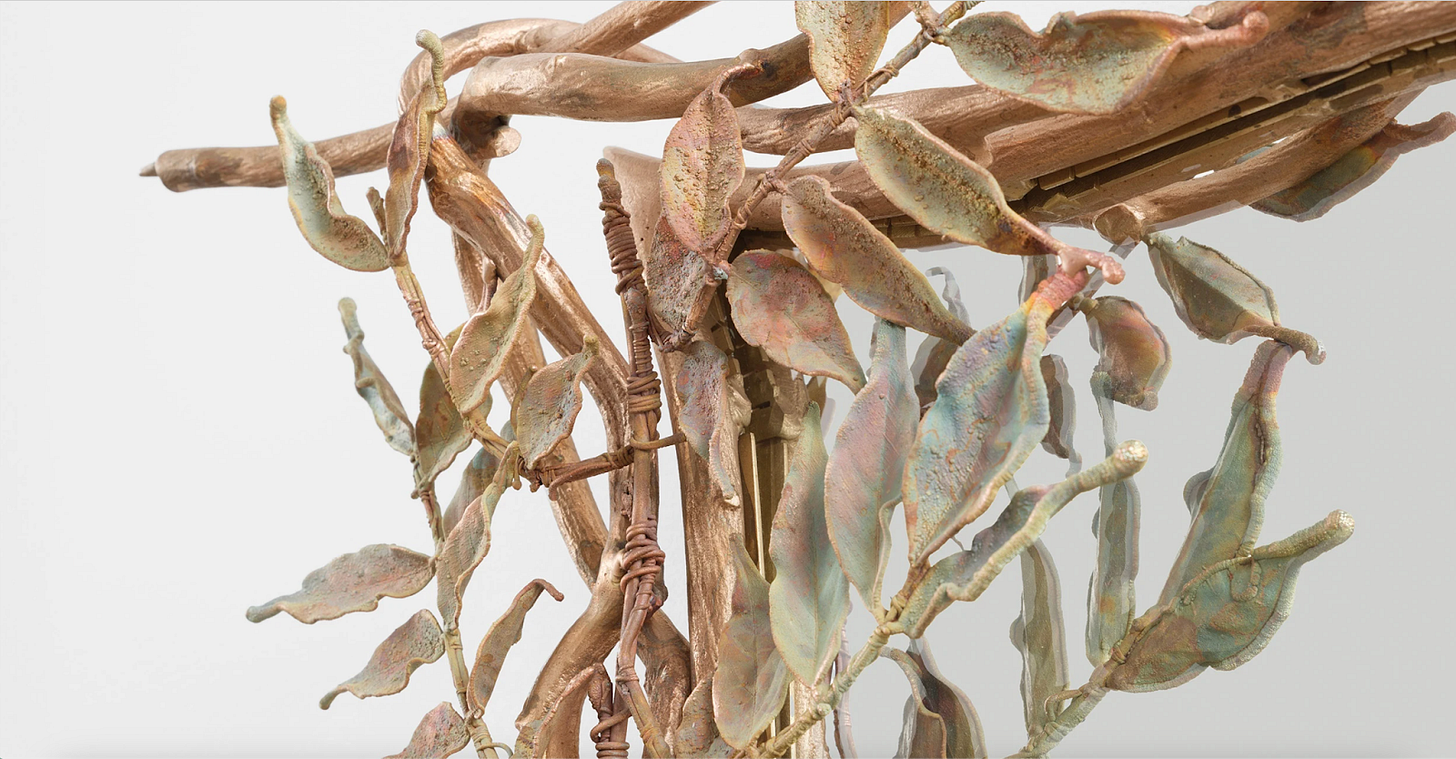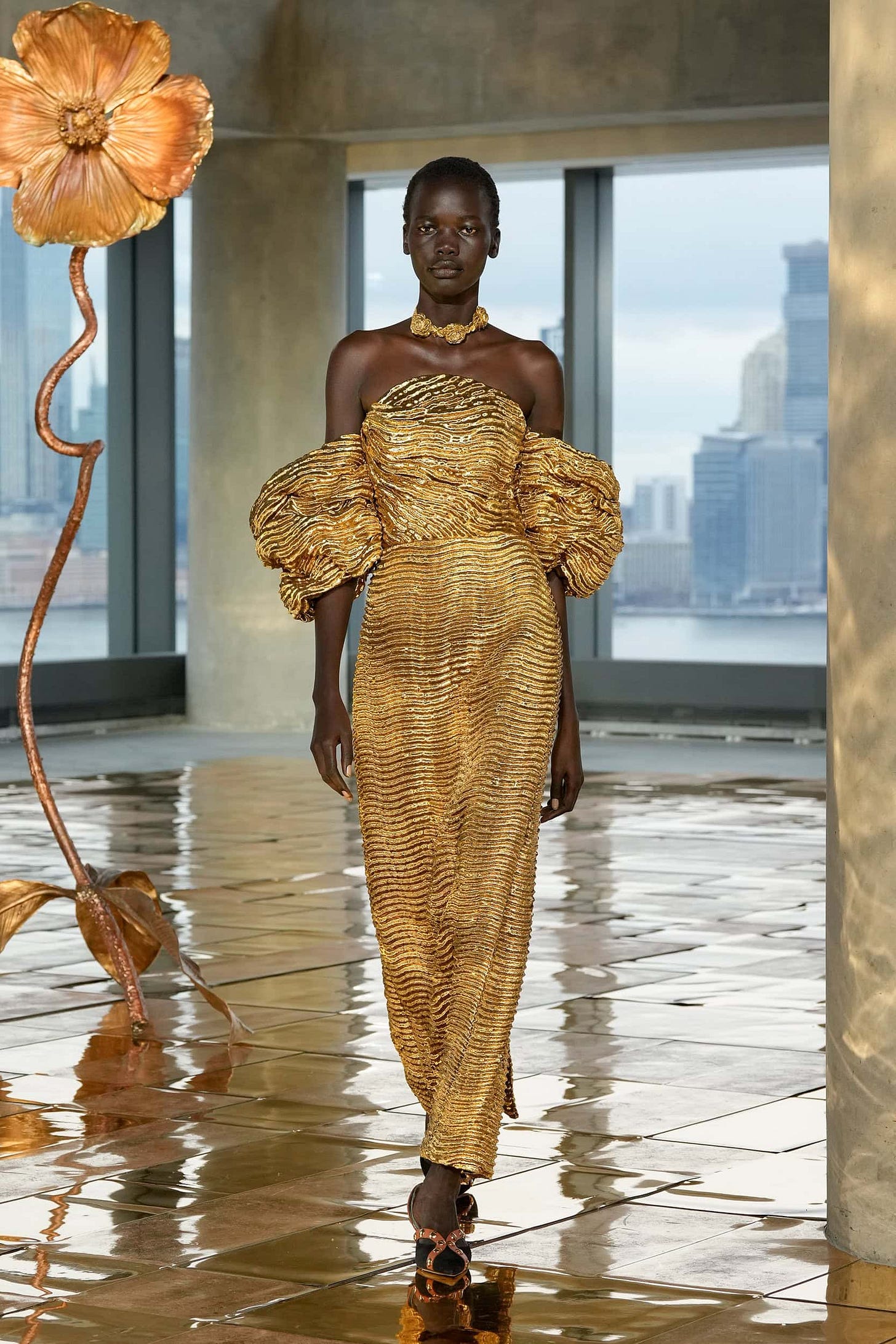Gilding Lilies and Other Acts of Defiance
Julie Hamisky, Crafting as Rebellion, and the Art of Making Things Last
We live in an era of speed and excess—where fast fashion cycles out in weeks, images are generated in seconds, and artistic production is measured in content output rather than skill.
Everything is made to be replaced. Nothing is made to last.
This is not news.
But something interesting is happening.
Across disciplines, craft is making a quiet return. In art, in fashion, in design, there’s a growing movement toward material intelligence, process-driven work, and objects that resist disposability. This isn’t just an aesthetic trend—it’s a cultural and philosophical shift.
Because when everything is immediate, the mark of distinction is slowness. When everything is automated, the new luxury is handmade. And when everything is disposable, preservation itself becomes a political act.
This is what makes Julie Hamisky’s work feel so vital right now.
Her latest exhibition, Transference at Kasmin Gallery, is a meditation on permanence, materiality, and what our society reveres. Large-scale electroplated flowers, shimmering with metallic permanence, hold onto their organic past. They are fragile but enduring, transformed but still themselves. Each petal, each stem, preserved in a state of in-betweenness—no longer living, but not quite dead.

Hamisky’s work makes an argument: that beauty is not the opposite of meaning, but a pathway to it. That making something well, with care and intention, is not an act of naivety but a statement about what we value. Each piece speaks to something fundamental—the tension between fragility and endurance, between nature and artifice.
And most importantly, that preservation is a political act.
Gilding the Flower (And Other Radical Acts of Preservation)
Gilding, the act of decorating objects with gold, silver or other alloys in leaf or powder form, has always been a symbol of power. We gild what we consider sacred—saints in cathedrals, palaces of kings, artifacts deemed worthy of survival. Historically, this has been reserved for the monumental, the man-made, the imperial.
Hamisky reverses this logic. She doesn’t gild statues or monuments; she gilds flowers. Small, natural, ephemeral things. And in doing so, she asks: What deserves to last?
This is not just an aesthetic question; it’s an ecological one. In an era of mass extinction, resource depletion, and environmental collapse, the idea of preserving nature—not in theory, but in tangible, material form—becomes a radical gesture. Instead of extraction, preservation. Instead of consumption, care.
But preservation is not only about objects. It is also about knowledge.
If Hamisky’s work asks what should endure, it also asks how things endure. A gilded flower is more than a frozen fragment of nature—it is the result of a process, a technique, a tradition carried forward.
The Political Act of Learning from your Grandmother: Artisanship, Power and Knowledge Preservation
For most of human history, craft, technique, and artistry were passed down through apprenticeship, through touch, through watching and doing. Before institutions and archives, before knowledge could be uploaded and downloaded at will, there was the act of learning from someone’s hands.
This is what makes Hamisky’s work feel particularly significant: it is not just about what lasts, but how things last.
Her ability to electroplate a flower, to transform the fragile into the enduring, was not learned in isolation. It was learned through proximity—through the legacy of Claude Lalanne, her grandmother, who mastered this very process, who preserved nature in metal not just as a technique, but as a philosophy.

To work in a lineage like this is not to be trapped in history. It is an acknowledgment that knowledge is not just something we accumulate, but also something we inherit. Something we can build off of. Standing on the shoulders of giants and such.
This is especially true when we talk about knowledge passed down between women. So much of what has been historically coded as feminine—craft, ornamentation, decoration, the intimate rather than the monumental—has been dismissed as secondary, decorative, unworthy of being called ‘Art’.
But there is an incredible power in the things that are made carefully, that are taught with patience, that carry the imprint of time not just in their form, but in the way they are learned. Read correctly, these objects can give you hints of the story of global events, personal histories, trade, intercultural exchange, the rise and fall of civilizations, the variety of societal values put on relationships, and emotional moments that were crucial in shaping the objects that stand before you. The physical act of crafting forces the maker to spend time with their object, and each touch imbues it with a new animism, if we just listen closely enough.
Sometimes handicraft is positioned as contrary to modernity and technological innovation. From where I sit, this could not be further from the truth. Technology has expanded the ways in which we share knowledge, the ways in which craft and artistry can reach beyond bloodlines, beyond geography. But there is something uniquely human about knowing where your work comes from—not just intellectually, but in your hands, in your memory.
Hamisky is not simply inheriting a technique. She is inheriting a way of thinking about materials, about permanence, about what is worth saving. And she is carrying it forward—not as replication, but as transformation.
Ecofuturism in Practice: Where Craft, Nature, and Technology Converge
I want to take a little sci-fi turn here, because I tend to see art through the lens of what does this say about what we value today, and what we want to value tomorrow.
There is a distinctly ecofuturist sensibility in Hamisky’s work—a philosophy and aesthetic movement that envisions a future where technology and nature coexist in regenerative, sustainable, and symbiotic ways, rejecting extractive practices in favor of innovations that restore, rather than deplete, the environment. Unlike the modernist impulse to erase organic forms in favor of clean lines and industrial materials, she leans into the intricacies of the natural world. Every vein in a leaf, every wrinkle in a petal, every asymmetry is preserved and venerated through technology, not erased.

Her work is not about recreating the past, but about reimagining the future—one in which human intervention amplifies rather than erases the complexity of the organic world. The future she suggests is not one of sleek, dehumanized efficiency, but of intimacy with materials, patience in process, and reverence for the natural.
We're seeing this shift across disciplines. After decades of mass production and aesthetic homogenization, craft is making a comeback. Fashion, long dictated by speed and overconsumption, is starting to see cracks —the best iterations of the "quiet luxury" movement prioritize materiality and process over pure branding (think the rise and fall of Logomania). The resurgence of haute couture houses like Schiaparelli and Alaïa reflects a return to singular, meticulously crafted pieces—designed for the runway not just as garments, but as storytelling objects, where materiality is both the medium and the message.

In art, we’re witnessing a parallel embrace of the tactile, the intentional, the beautiful.
This is why Hamisky’s work, and the broader craft movement, feels so timely. The future isn’t about transitioning our physical reality to more closely replicate a digital one – where replication and iteration are endless — it’s about rethinking how we use technology in harmony with material intelligence. Those paying attention are already shifting their focus toward what lasts, what carries meaning in its making, what resists the churn of trend cycles.
Hamisky isn’t theorizing about preservation; she is preserving. She isn’t commenting on craftsmanship; she is practicing it.

And in doing so, she challenges one of the most entrenched assumptions of contemporary art: that concept matters more than creation, that craft is secondary, that meaning must be difficult. There is something radical in that!
What Comes Next?
I don’t know if the age of things made to last is truly returning.
I hope it is.
Because I think there is something deeply reassuring about the idea that what we make—what we choose to preserve—matters. That artistry is not just about what we say but how we shape the world around us.
Hamisky’s work is a reminder that the most radical thing an artist can do right now might just be to make something well—to care about the material, to take the time, to leave behind an object that carries meaning in its very construction.
And if that is where we are headed, it’s a future worth looking forward to.






I found this to be a stimulating reorientation of traditional assumptions. Your emphasis on gilding as an act of preservation struck me, especially in how it inverts the usual sense of wasteful action "gilding a lily" implies (here I'm thinking of Shakespeare, King John, Act 4, Scene 2; "To gild refined gold, to paint the lily, to throw a perfume on the violet... Is wasteful and ridiculous excess"). I am sure that Hamisky is consciously playing with Shakespeare, but I'm curious what your thoughts are concerning the intersection between "preservation" and "waste." In fashion, just as in the art world, does the act of gilding subtract from the natural allure of ephemeral beauty? Does "trapping" a moment somehow diminish its value? Is painting the lily not just a wasteful, but a suppressive act?
I feel like the connotations of gilt in the present political climate cannot be ignored either. As we navigate the present ecocide created by capitalistic consumption, preserving and sustaining feel both political and necessary. Recent calls by billionaires and politicians to return America to a "Gilded Age" seem equally germane: can we reclaim gilt as a veneration of the sacred when its metaphor is conceptually linked with the suppression of the working class? Is it ethical to distract from the suffering and poverty of the proletariat with a thin veneer of gold? Curious to know your thoughts.